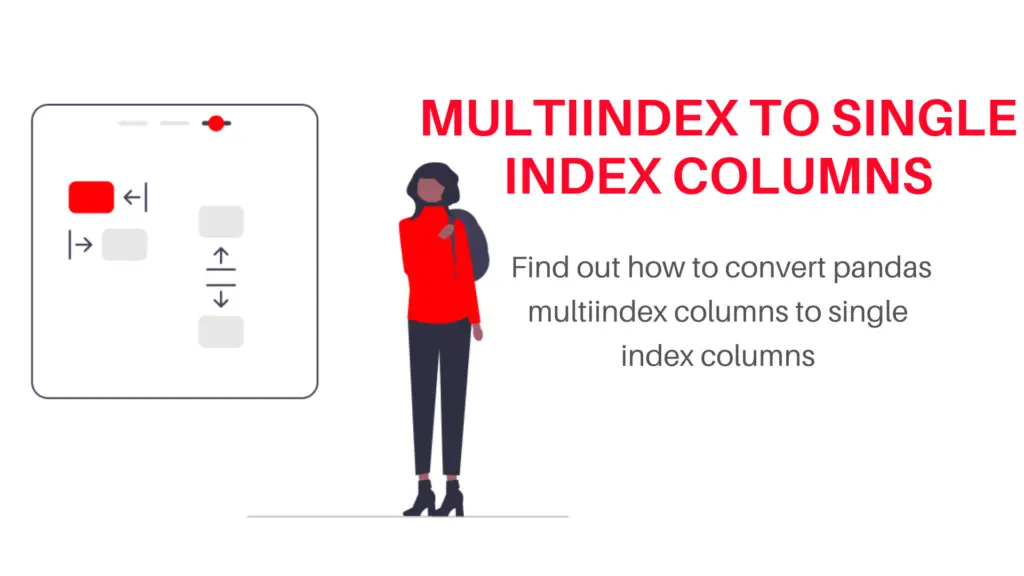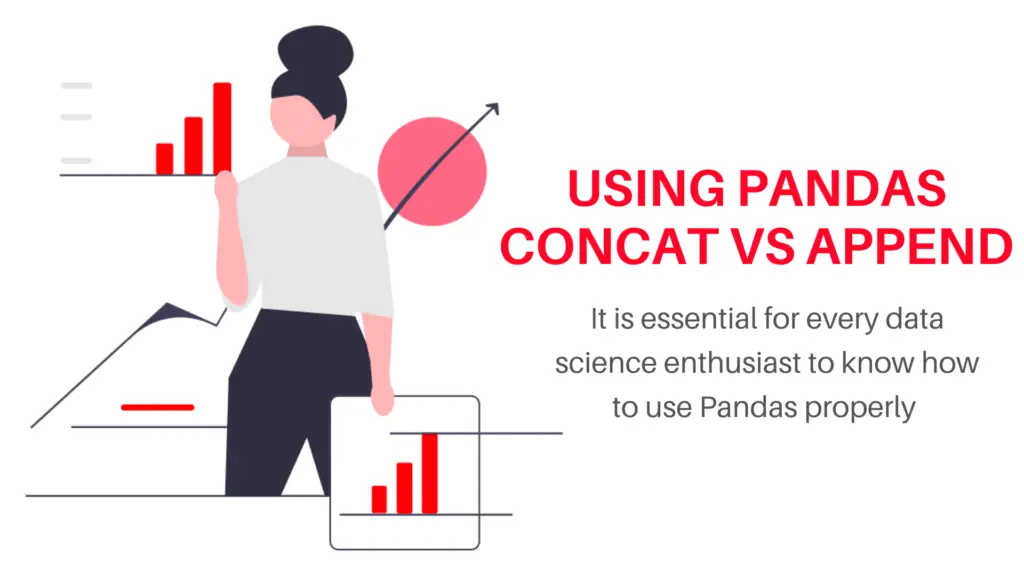Pandas in Python have high capabilities when it comes to data aggregation. Pandas join vs concat can be used to aggregate data in tables and data essentially makes better sense when multiple pieces of data are put together. There are multiple such codes offered by Pandas to aggregate data like join, concat, merge, append, etc. In this article, we’ll go over comparing two of these 4 aggregation codes, namely Pandas Join vs Concat, and see how these codes can be used to aggregate data to make information more comprehensive altogether.

Also, read -> Tidy Data in Python: Easy ways to Clean your data!
What is Pandas?

A brief introduction to anyone who has not used Pandas before, it is an open-source library (developed in 2008) essentially used for working with relational or labeled data or both, easily and almost replicating Excel and SQL in python. It can work with many data structures and operations for manipulating data in text and/or numbers and time series. Built on top of the NumPy library in python, it is fast and has high performance and usability.
For more about Pandas, check out the official documentation here: Pandas Official website
Check out this free Pandas tutorial if you are new to Pandas: Kaggle Pandas tutorial
Pandas Join vs Concat for Data Aggregation
Of the four major data aggregation codes that there are, the Pandas Join vs Concat functions are two of the most used functions for data aggregation and bringing data in different tables together in one. Using the pandas Concat and Join codes is important for any data analyst or data science enthusiast in order to perform high-level data analyses.
Let us get right to understanding what the Pandas library’s data aggregation codes of pandas join vs concat offers to its users.
Pandas Join
The pandas join function can be used to join columns of another data frame with a given data frame either on an index or key basis effectively passing the objects through a list. The parameters can be used to change the type of join being performed which can be seen to be a similar representation of the SQL joins i.e. the inner, left, right, cross, and outer join. The default join performed is the left join.
This serves a different purpose from the pandas concat function. This function specifically is for those users who want to replicate a SQL level join in Python.

The syntax of the code looks as follows;
import pandas pandas.join pandas.join(other, on=None, how='left', lsuffix='', rsuffix='', sort=False)
The different types of joins that can be performed are: (as per the official Pandas documentation)
- Left: use calling frame’s index (or column if on is specified)
- Right: use other’s index.
- Outer: form union of calling frame’s index (or column if on is specified) with other’s index, and sort it. lexicographically.
- Inner: form intersection of calling frame’s index (or column if on is specified) with other’s index, preserving the order of the calling’s one.
- Cross: creates the cartesian product from both frames, and preserves the order of the left keys.
An example of the Pandas Join function is given below:
Consider the following two datasets or data frames in Pandas;
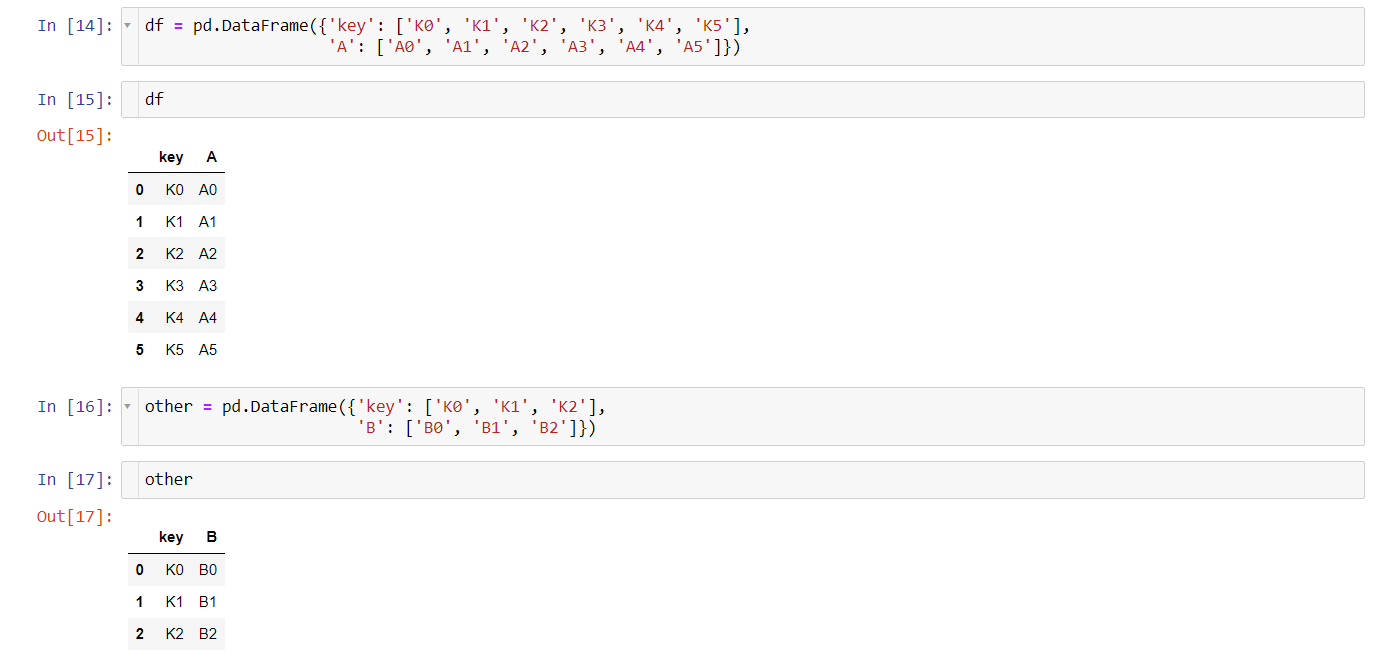
The data frames are created using the examples as shared in the documentation of python Pandas, to make referencing easier if one chooses to look into the docs. The data frames are titled ‘df’ and ‘other’ and have two columns in each with ‘key’ being the common column (to ease the understanding of the join function)
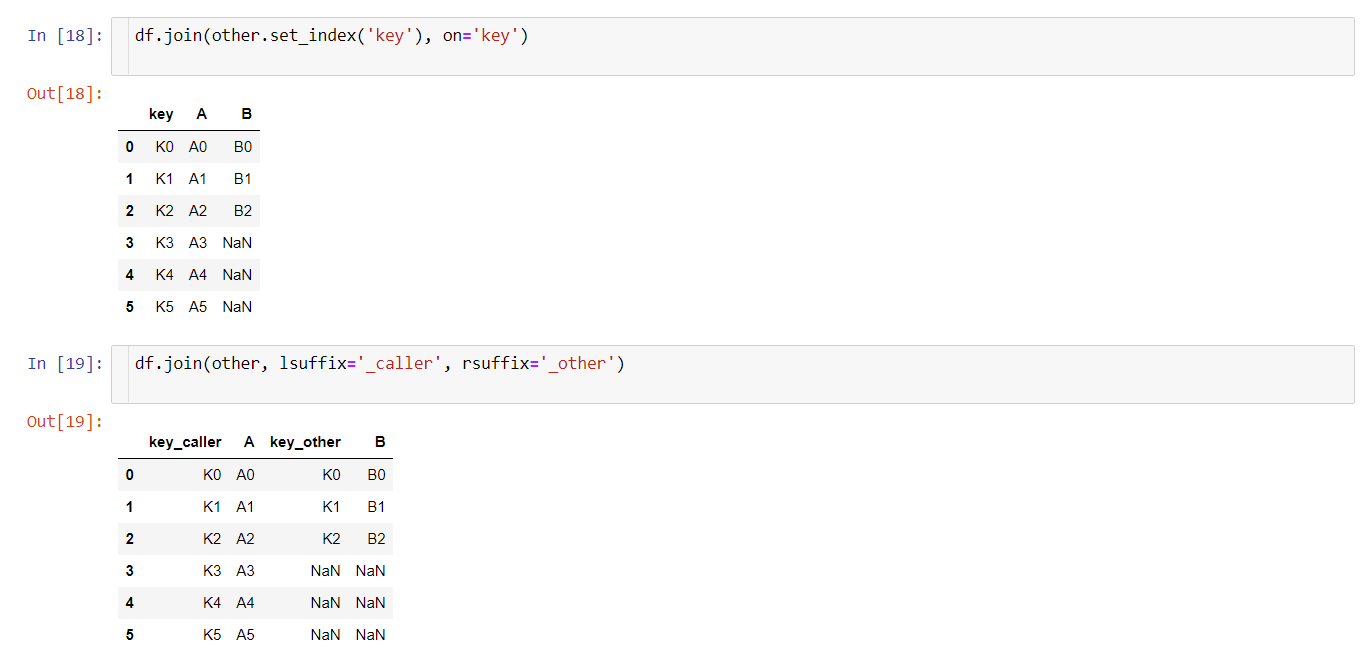
The join can be performed in two easy ways (other than which, the documentation has enough methods to use but these two are all you’ll need);
(Note: how the elements that don’t have another element to join or are excess rows, are imputed with NaN’s)
- The join can be performed by specifying the index on both the data frames using the set index command. Once the index is in place, the join only needs to know ‘on’ what column do you want to join the data frames. In this example, we’re joining on the ‘key’ column on the data frames df and other, and the join is executed accordingly.
- The other way to do this is to specify the data frames to be joined i.e. df and other, and then specify the suffixes of the left and right tables and then join the tables or data frames vertically as they stand. In this case, the tables are now joined and the empty rows are still filled with NaN’s.
Also, it is important to remember that after the NaN’s appear in the output of a join, they don’t necessarily have to be replaced with 0’s or removed because knowing that there is no element in the join at that point is good information to hold. Replacing them with 0’s or other elements will impact your analysis adversely and is best if avoided.
Find out more about the Pandas Join function here: Offical Pandas Join Documentation
For a comprehensive video explanation, check out this YouTube video:
Pandas Concat
The most widely used function in data aggregation today is the Pandas Concat function which is used to combine data frames in Python and is used for more cases than just for a simple connection between two or more data frames as you will see below.

The syntax of the code looks as follows;
import pandas
pandas.concat
pandas.concat(objs, axis=0, join='outer', ignore_index=False, keys=None, levels=None,
names=None, verify_integrity=False, sort=False, copy=True)The Concat function can be used for any of the following use cases (as per the official Pandas documentation);
- Combine two Series.
- Clear the existing index and reset it in the result by setting the ignore_index option to True.
- Add a hierarchical index at the outermost level of the data with the keys option.
- Label the index keys you create with the names option.
- Combine two DataFrame objects with identical columns.
- Combine DataFrame objects with overlapping columns and return everything
- Combine DataFrame objects horizontally along the x-axis by passing in axis=1.
- Combine DataFrame objects with overlapping columns and return only those that are shared by passing inner to the join keyword argument.
A simple example of the Concat function can be seen below:

To join data frames together instead of series, use the following code:
df1 = pd.DataFrame([['a', 1], ['b', 2]],
columns=['letter', 'number'])
df2 = pd.DataFrame([['c', 3], ['d', 4]],
columns=['letter', 'number'])
pd.concat([df1, df2])
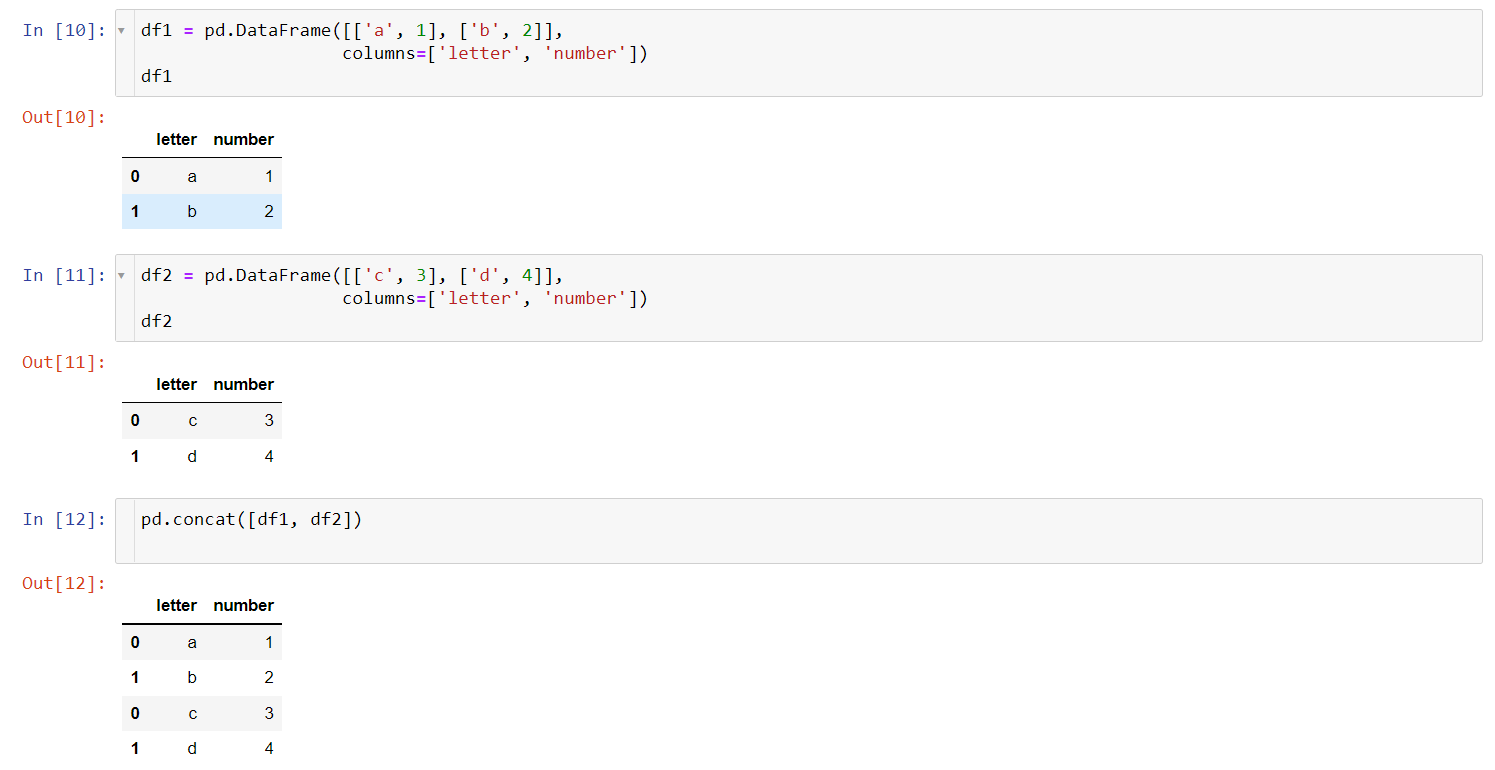
As you see, using the pandas concat is fairly simple and can be understood by a beginner as well
To change the axis and join the data frames horizontally, modify the code as follows to mention an axis = 1.
pd.concat([df1, df4], axis=1)
Some other examples of how to use concat are given below for you to try out.
pd.concat([df5, df6], verify_integrity=True) pd.concat([df1, df3], join="inner") pd.concat([df1, df3], sort=False) pd.concat([s1, s2], ignore_index=True)
- Verify integrity helps avoid duplicate indexes
- Join inner helps return only the common elements
- sort False will disable index sorting
- ignore index gives the resulting data frame a new index starting at 0.
Find the Pandas Concat function documentation here: Pandas Concat Docs
Check out this youtube video for more about how to use the Pandas Concat Function:
When should you use Pandas Join vs Concat? (Differences)
As depicted from the examples and from what the code really means in the case of Pandas join vs concat, the use cases of Pandas join and Pandas concat differ.
- Using the Pandas join is particularly advantageous when your dataset is supposed to be joined with another dataset that has some sort of a conditional role involved. The join can be a join of common elements or elements in one dataset completely but not the other etc. in which case, the pandas join function has capabilities to make it easy for such a combination of data to be executed.
- Using the Pandas concat is better when such conditions are not involved and the combination or concatenation is more or so based on making pure combinations without having the involvement of a condition. The concat code is also fairly better when only parts of a table are to be joined with parts of another table making a new table altogether with different parts.
Conclusion
The data aggregation requirements can occur in any analysis and most analyses require more than one dataset to be put into use to understand more of the data. The data can make complete sense only when it is comprehensive and when all the pieces are put together to make the data whole. The idea behind combining multiple data frames simply comes from the fact that different departments and sources of data are used in order to make conclusions from data about a population.
Therefore, understanding how data can be aggregated using functions like Pandas Join vs Concat is an important part of anyone’s data science or coding journey.
Try using the Pandas Join and Concat codes in your analyses and let us know in the comments below what you prefer for combining data.
For more such content, check out our website -> Buggy Programmer



